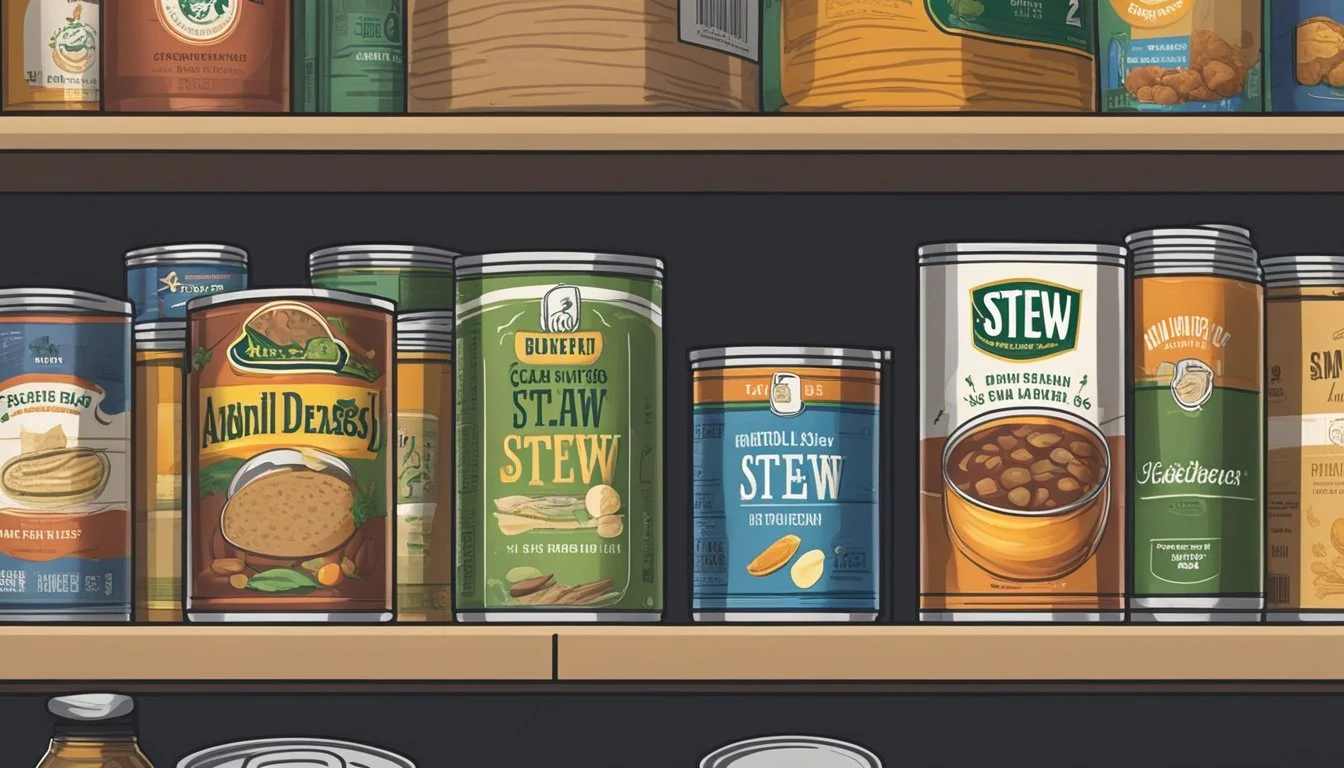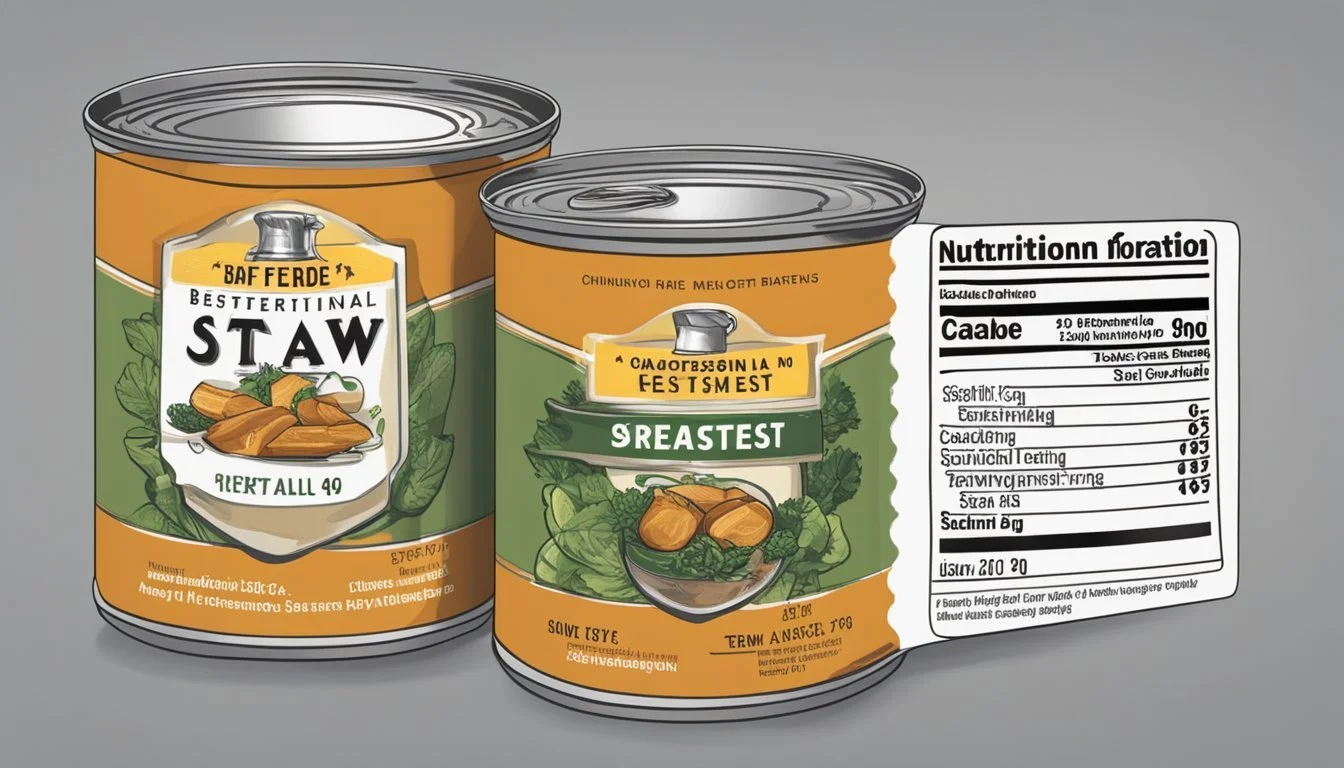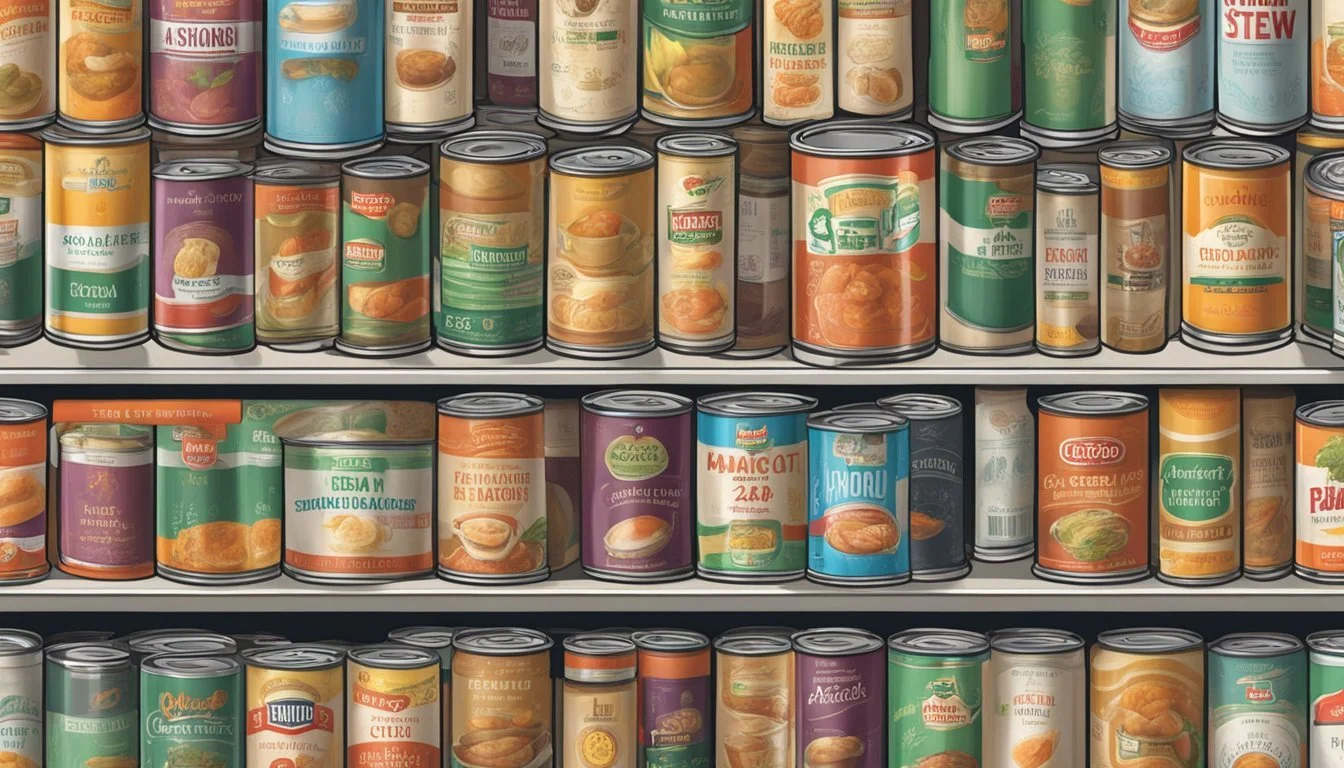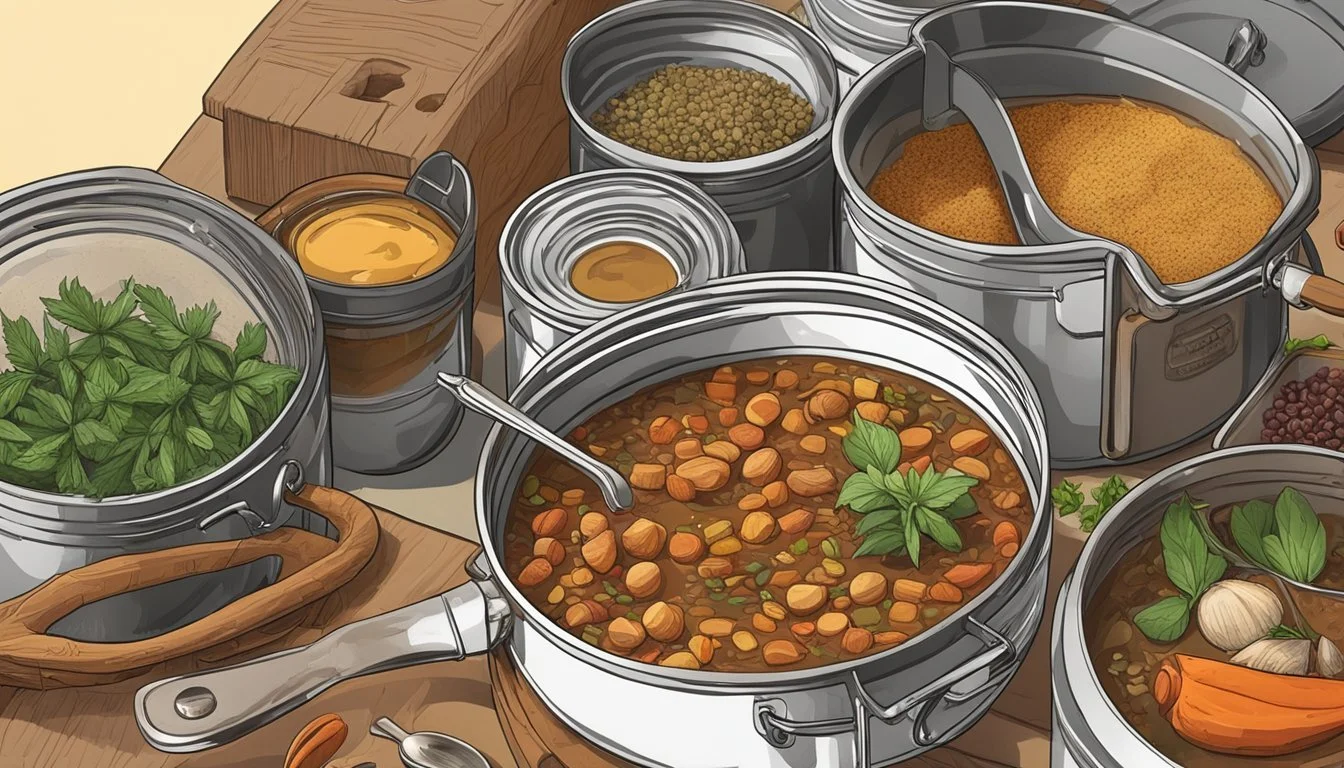How Long Does Canned Stew Last?
Shelf Life and Storage Tips
Canned stew, a staple in emergency preparedness and convenient meal planning, offers a significant shelf life compared to its fresh or refrigerated counterparts. Precise storage conditions play a critical role in maximizing the longevity and safety of canned goods, with a cool, dry environment being ideal. The industry standard, as informed by entities such as the USDA, suggests that high-quality, home-canned foods, like stew, are best consumed within a year, although commercially canned goods may offer a longer shelf life.
Understanding the specifics of expiration dates and "best by" labels is crucial for consumers. These guidelines help determine the window during which the product is at its peak quality. It is important to note that while canned stew often remains safe beyond these dates, the quality in terms of flavor, texture, and nutritional value may decline. Post-opening, canned stew should be refrigerated and is typically good for consumption within 3 to 4 days. Observing can integrity and storage best practices ensures that the stew maintains its intended safety and quality standards.
Understanding Canned Stew Shelf-Life
Canned stew is known for its extended shelf life, which is attributed to the canning process that effectively preserves the food within. It is essential for consumers to understand the underlying factors that contribute to this longevity to ensure they maximize the benefits of canned food.
Fundamentals of Canned Stew Preservation
Canned stew maintains its quality and safety over an extended period, typically between two to five years, when properly stored. The foundation of its preservation lies in the hermetic sealing of the product, creating an airtight environment that significantly retards spoilage. It is critical to store canned stew in conditions that are cool and dry to prevent deterioration that could be caused by environmental factors.
Impact of Canning Process on Shelf-Life
The canning process significantly enhances the shelf-life of stew due to the high-heat treatment it undergoes, which eliminates most spoilage organisms and enzymes. This process also creates a vacuum seal, preventing the ingress of air and the recontamination of the food. While an expiration date is often stamped on the can for quality assurance, it does not necessarily signal that the food is unsafe to consume past this date, but rather indicates peak quality. Proper attention to storage practices remains a key factor in preserving the integrity of the can and its contents over time.
Storage Guidelines for Canned Stew
Proper storage of canned stew is crucial for maintaining its quality and safety. The shelf life can be maximized by adhering to optimal conditions and understanding the differences between refrigerator and pantry storage.
Optimal Storage Conditions
Canned stew should be stored in a cool, dry place where the temperature is consistently below 75 degrees Fahrenheit. It's important to protect the cans from moisture and direct sunlight, as these factors can contribute to corrosion and compromise the stew's quality. The ideal storage location is a pantry or a cupboard away from any heat sources like stoves or heating vents.
Refrigerator Vs. Pantry Storage
Once opened, canned stew needs to be properly refrigerated if not consumed immediately:
In the Pantry: Unopened canned stew can last up to a year when stored in optimal conditions as outlined above.
In the Refrigerator: After opening, any leftovers should be transferred to a sealed container and can be refrigerated for 2-3 days. For home-canned stew, the USDA recommends consuming within this timeframe to ensure quality and safety.
Safety and Spoilage Indicators
A consumer must prioritize safety when evaluating canned stew longevity. This section breaks down the key indicators that signal spoilage, addressing tell-tale signs of potential contamination.
Identifying Spoiled Canned Stew
Food safety experts assert that canned stew should not be consumed if the product shows signs of spoilage. Spoilage is often detectable by unexpected changes in appearance, smell, or taste. Consumers should discard cans if the stew exhibits an off odor, color change, or a sour or metallic taste, as these are clear indications that the product is no longer safe for consumption.
Physical Contamination Signs
Physical signs of contamination in canned stew can include:
Can Integrity: Any form of can damage, such as deep dents, rust, or swelling, compromises the seal and can lead to spoilage.
Leaking or Bulging: Cans that are leaking or display bulging suggest possible bacterial growth, including botulism, which is a grave safety concern.
It's imperative that the seal remains intact. Consumers should examine the can prior to purchase or use, avoiding those with any visible compromise to their structure.
Chemical Contamination Signs
Chemical signs are not always visible, but they can indicate spoilage. The key chemical sign to look out for is:
Foul Odor: Upon opening a can of stew, a noticeable foul smell can indicate the presence of bacterial byproducts from pathogens or spoilage bacteria that may produce toxins.
Cans that spurt liquid or foam when opened may be under pressure due to gas produced by bacteria, and the contents should not be tasted or used. In this case, chemical contamination is high, and the can's contents should be considered unsafe for consumption.
Nutritional Considerations
When evaluating the nutritional value of canned stew, it is essential to assess the retention of nutrients over time and how it compares with its fresh counterpart.
Nutrient Retention in Canned Stew
Canned stew is convenient and has a long shelf life. The canning process typically involves high heat, which can reduce the levels of certain heat-sensitive vitamins such as vitamin C and certain B vitamins. However, it protects the food from spoilage and can in fact increase the bioavailability of certain nutrients like lycopene. Key vitamins and minerals such as iron, potassium, and some fat-soluble vitamins like A and D tend to remain stable during the canning process. The nutritional value largely remains intact over the course of its shelf life, which can extend from 2 to 5 years for low-acid foods like canned stew.
Comparing Freshness and Canned Nutrition
Fresh stew often has a higher content of certain vitamins that are sensitive to heat when compared to canned stew. However, canned stew still provides essential nutrients needed for a balanced diet. It must be noted that the nutritional difference can be minimal, depending on the length of time the fresh stew has been stored before consumption and the cooking methods used. During the time it takes for fresh produce to be transported and stored, nutrient degradation can occur. In comparison, canning preserves the nutritional value from the time of packaging, which means that canned stew could, in some instances, offer more consistent nutritional value than a fresh stew that has been stored for an extended period.
Factors Influencing Canned Stew Longevity
Canned stew longevity is primarily influenced by the ingredients it contains, the production quality, and the acidity level. Understanding these factors helps ensure maximum durability of the product.
Role of Ingredients in Shelf-Life
The ingredients in canned stew, such as vegetables, beans, corn, and meat, all contribute to its shelf-life. Typically, a canned beef stew, (What wine goes well with beef stew?) for instance, contains a mix of these components:
Vegetables: Can act as preservatives due to natural antioxidants.
Beans: High in proteins, may affect the preservation process.
Corn: Low-acid content can extend shelf-life in a sealed environment.
Meat: Usually canned meats are processed to be shelf-stable, but over time they could affect the flavor and texture quality of the stew.
Impact of Production Quality on Longevity
High production standards are essential for ensuring the longevity of canned stews (What wine goes well with stews?). The following aspects are crucial:
Seal Integrity: The can's seal must be perfect to prevent bacterial growth.
Heat Processing: Proper heat application ensures that the stew is free from harmful microbes and is safe for consumption.
The Effect of Acidity Levels
The acidity level in canned food is a determining factor for shelf-life.
Low-acid foods: Stews with low-acid ingredients like beans and canned meat can usually last 2 to 5 years.
High-acid foods: Ingredients such as canned tomatoes may make the stew more acidic, which could potentially shorten the shelf-life due to the nature of high-acid foods.
Usage of Expired Canned Stew
When dealing with expired canned stew, it is crucial to understand the potential health risks and adhere to federal guidelines to ensure safety. Here are the considerations regarding the consumption of canned stew past its expiration date.
Risks of Consuming Expired Products
Consuming expired canned stew can pose health risks due to the potential for food spoilage and bacterial contamination, such as botulism. Even if the can appears intact, microscopic spoilage cannot be ruled out without proper testing. Research indicates that after the expiration date, the integrity of the can’s contents is not guaranteed. Food spoilage is not always visible or detectable by smell or taste, thus relying solely on sensory perception can be misleading and unsafe.
USDA Recommendations
The USDA suggests that low-acid canned goods, such as canned stew, typically maintain their best quality for 2 to 5 years when stored properly. However, they also caution against the usage of canned foods that show signs of bulging, leaking, rusting, or severe denting. Once expired, the USDA does not guarantee the safety of canned stew, emphasizing the importance of adhering to expiration dates for health and safety reasons. The USDA has conducted extensive research into food safety, and their guidelines are based on a comprehensive understanding of food preservation and spoilage.
Handling Open Canned Stew
Once canned stew is opened, its shelf life reduces significantly. The key to maintaining safety and quality of the leftover stew lies in proper storage methods and understanding the safe consumption period.
Safe Consumption Period of Leftovers
After opening, the stew should be consumed within three to four days when stored in the refrigerator. The assumption is that it's kept at a constant refrigeration temperature of 40°F (4°C) or below, which inhibits bacterial growth.
Proper Storage Methods After Opening
To ensure the safety and maintain the quality of the leftover canned stew:
Transfer the leftovers to a glass or plastic airtight container.
Refrigerate promptly, avoiding leaving the stew out at room temperature for more than two hours.
For optimal quality, avoid subjecting the stew to repeated reheating, as this can degrade its texture and flavor.
Preventing Canned Stew Spoilage
To ensure the longevity and safety of canned stew, specific practices must be followed during the canning process and when storing the final product. These methods differ for home canning enthusiasts and commercial manufacturers, but both aim to prevent spoilage and maintain the quality of the canned stew.
Best Practices for Home Canning
Home canning is a method many people use to preserve their stews. To prevent spoilage:
Seal Integrity: They should ensure that the seal is vacuum-tight post-processing to avoid the entry of air, which can cause contamination. Using reputable brands like Ball or Kerr lids can help achieve a proper seal.
Canning Method: Depending on the stew ingredients, either pressure canning or water bath canning methods are appropriate. The National Center for Home Food Preservation recommends that stews with meats are processed using a pressure canner to reach the temperatures needed to destroy harmful bacteria.
Inspection: Before storage, they must inspect the lids for a proper seal and again periodically check for any signs of spoilage like rusting, bulging, or leaking.
Storage Conditions: Store home canned goods in a cool, dry place away from direct light to maintain quality and prevent spoilage.
Home canning requires attention to detail and adherence to recommended processing times to ensure food safety.
Commercial Canning Standards
Commercially canned goods undergo rigorous processes to ensure safety and longevity:
Regulated Standards: Commercial canning must meet strict standards for sterilization and safety, as regulated by food safety authorities.
Automated Sealing: Factories use machines to achieve consistent vacuum seals on cans, which is critical for preventing spoilage.
Expiration Dates: Companies label their products with expiration dates, and it is imperative to adhere to these dates to ensure the stew's quality and safety are maintained.
Quality Checks: Regular quality controls are conducted to check the seal integrity and the can's condition before leaving the manufacturer and upon arrival at the store.
By following these standards, commercial canners can ensure their stews remain safe and consumable for an extended period when stored under optimal conditions.
Identifying and Addressing Botulism Risk
When it comes to canned stew, understanding the risks associated with botulism and implementing safety measures are critical to prevent the potentially deadly effects of the botulism toxin produced by Clostridium botulinum.
Recognizing Botulism in Canned Stew
To identify botulism risk in canned stew, one must be aware that botulism toxin cannot be detected by sight, smell, or taste. If canned food shows signs of spoilage such as bulging cans, leaks, or off odors, it should be discarded immediately. Moreover, even the absence of these signs does not guarantee safety, as the toxin can still be present.
Preventive Measures Against Botulism
To mitigate the risk of botulism, the following safety precautions should be taken:
Canning Process:
Always adhere to proper canning techniques. This includes using the right temperature and pressure for the appropriate duration.
Acidity: Ensure that foods low in acid, like vegetables and meats including stew, are canned using pressure canning to reach the necessary temperature for killing Clostridium botulinum spores.
Post-Canning Precautions:
Boiling: Prior to consuming home-canned stews, boil the contents for at least 10 minutes to inactivate botulism toxin, with an additional minute added per 1,000 feet of elevation above sea level, which can neutralize the toxin.
Inspection: Regularly inspect your canned goods. Any doubt about the integrity of the canning should lead to disposal of the product.
By diligently observing these steps, one can significantly reduce the risk of botulism from canned stew.
Maximizing Flavor and Texture After Opening
Once a can of stew is opened, preserving its flavor and texture becomes a priority. To maintain the quality of the stew, it should be stored properly in the refrigerator and consumed within 3 to 4 days. The following subsections provide suggestions on reheating and serving canned stew for optimal taste and how to enhance its flavor with additional ingredients.
Reheating and Serving Suggestions
Reheating stew properly is crucial for maintaining its texture. It is best heated over medium heat on the stovetop, stirring occasionally to prevent it from sticking and to ensure even heating. If time is short, microwaving the stew in a microwave-safe container covered with a lid or microwave-safe plastic wrap can work, but it should be done in intervals, stirring between each to help preserve the stew's original texture.
Enhancing Taste with Additional Ingredients
To elevate the taste of canned stew after opening, consider incorporating fresh ingredients. Adding a pinch of salt or a dash of pepper can bring out existing flavors. For a more complex palette, one might introduce herbs like thyme or rosemary. Vegetables such as diced carrots or potatoes can not only add nutrition but also enhance the stew's texture. To enrich the stew's base, a splash of red wine or a spoonful of tomato paste can deepen the flavor profile.
Understanding Food Labels and Expiration Dates
When choosing canned stew, it is important to understand the meaning behind labels and dates to ensure food safety.
Reading Canned Stew Labels
Canned stew labels provide crucial information about the product inside. These labels typically include a sell-by date, expiration date, or use-by date, which can guide consumers on how long a can may be stored before its quality diminishes. For the most accurate assessment of a canned stew's shelf life, one should look for and carefully read these dates. Furthermore, the labels may contain storage recommendations and nutritional information.
Significance of Expiration and Sell-By Dates
The expiration date on canned stew is the manufacturer's estimate of when the product will no longer be at peak quality. It's worth noting that canned foods can generally last beyond these dates if stored properly—in a cool, dry place, and in intact, undamaged cans. A sell-by date is used by retailers to know how long a product can be displayed for sale. While these dates are helpful, they are not the sole indicators of food safety. Consumers should examine cans for signs of damage, such as bulging or rust, which may affect the stew's safety and edibility regardless of the printed date.
Canned Stew as Part of a Healthy Diet
Canned stew offers a convenient and versatile meal option that can be part of a balanced diet. When chosen wisely and incorporated properly, it can contribute to nutritional needs with ease.
Incorporating Canned Stew into Balanced Meals
To ensure a balanced diet, one should look for canned stews that are high in protein and low in added sugars and sodium. Quality canned stews often contain meats, vegetables, and a rich broth that can contribute to the daily intake of essential nutrients. To optimize nutritional value, individuals can:
Add fresh vegetables to increase fiber and vitamin content
Pair the stew with whole grains, such as brown rice or quinoa, for added minerals and B vitamins
Selecting stews with a variety of vegetables can also help meet the recommended servings of vegetables per day, enhancing the overall health profile of meals.
The Convenience and Versatility of Canned Stew
Canned stews are known for their convenience, being ready to eat within minutes and requiring no refrigeration prior to opening. This makes them a valuable asset for quick meal solutions and emergency food supplies. The versatility of canned stew is apparent in its ability to serve as both a standalone dish or a base for more complex meals. For busy individuals, the ease with which a nutritious meal can be prepared is a significant advantage. Additionally, the long shelf life of canned goods ensures that nutritious options are available year-round, regardless of season or fresh produce availability.










